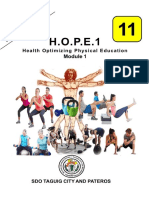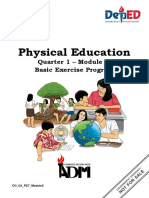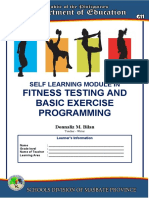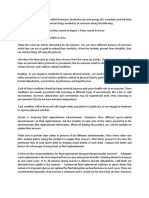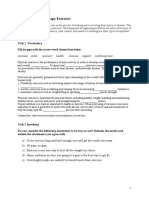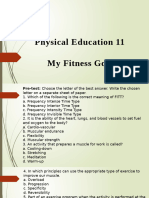PED 026 SAS Lesson 5
PED 026 SAS Lesson 5
Uploaded by
Glenn PlecisCopyright:
Available Formats
PED 026 SAS Lesson 5
PED 026 SAS Lesson 5
Uploaded by
Glenn PlecisCopyright
Available Formats
Share this document
Did you find this document useful?
Is this content inappropriate?
Copyright:
Available Formats
PED 026 SAS Lesson 5
PED 026 SAS Lesson 5
Uploaded by
Glenn PlecisCopyright:
Available Formats
PED 026: Fitness Exercises
Students’ Activity Sheet: Module #5
Name: _______________________________________________________ Class number: _______
Section: ____________ Schedule: __________________________ Date: ______________
Lesson title: DESIGN IMLEMENTATION Materials:
Lesson Objectives: Activity Sheet, watch that
Upon completion of this module, you should have: measures second/ stopwatch,
1. Implemented regularly upon yourself the sports conditioning measuring tape, meter stick/ruler,
training program you have designed. weighing scale
2. Demonstrated improvement in the parameters or corrected
the deficiencies noted in the fitness assessment form. References:
(South Western University Tertiary
1. PE module)
Productivity Tip:
Productivity tip: Take a quick break after every hour of work. Stand up, drink water, and do some stretches to
relieve any stiffness. Look outside and focus on green things to relieve eye strain.
A. LESSON PREVIEW/REVIEW
Introduction (2 mins)
Welcome to Lesson 9! Do you want to feel better, feel lighter, have more energy, have more focus?
Just exercise! There are so many good reasons to start moving and using those muscles. Specialists at
the the Mayo Clinic say that the health benefits of regular exercise and physical activity benefits
everyone no matter your gender, age, or physical ability. (https://www.mayoclinic.org/healthy-
lifestyle/fitness/in-depth/exercise/art-20048389 ) Some of the benefits they listed include: 1) weight gain
or weight loss; 2) protection from health conditions and diseases like stroke, high blood pressure,
diabetes, depression, arthritis, and many types of cancer; 3) improved mood; 4) improved energy; 5)
better sleep; and 6) it can be fun and social.
As we continue our journey to a healthier and stronger version of ourselves, let learn a bit more about
how we and those around us can be healthier and stronger too.
B. MAIN LESSON
Activity 2: Content Notes
Prerequisites:
Exercise is better performed early in the morning or in the evening.
It should not be done on a full stomach.
People who have followed a sedentary or quiet lifestyle should begin an exercise program slowly.
It is not important how quickly one advances to a higher level of fitness. Becoming fit eventually
and maintaining that fitness is what matters.
A slow and easy start can avoid musculoskeletal injuries. Be sure to thoroughly warm up before
This document is the property of PHINMA EDUCATION 1
PED 026: Fitness Exercises
Students’ Activity Sheet: Module #5
Name: _______________________________________________________ Class number: _______
Section: ____________ Schedule: __________________________ Date: ______________
beginning and cool down gradually by stretching, appropriate to the exercise. This is very
important to prevent cramping and other discomforts.
Choose activities that you like.
Be realistic about what you can do.
Exercising in a group is better than doing it alone because it makes it a social event and
encourages continuous participation.
One has to consult a doctor before starting an exercise program. Also stop and check with your
doctor right away if you develop sudden pain, shortness of breath, or feel ill.
Choose your method of exercise carefully! Make sure it is suitable for your body type. Avoid high-
impact events. Certain exercises should not be performed when people have certain diseases.
People with diabetic retinopathy should not perform exercises that involve bending forward too
much or standing on their head.
People with weak heart should not perform strenuous exercise. Those who have had a heart
attack cannot perform any exercise other than walking for a certain period after recovery.
Be very certain to remain hydrated by continuously drinking water supplemented with vitamin C
and electrolytes while exercising.
Even those confined to bed should have some kind of physical activity or at least physiotherapy to
avoid bedsores, chest infection, and loss of strength of bones, constipation and depression.
Observe physical distancing, proper donning and doffing of mask and hand washing when
exercising in areas at risk for droplet or airborne infection.
The mask does not compromise breathing. It is an effective way to prevent viral transmission in a
community context, provided that compliance is high.
Activity 3: Skill-building Activities
Teaching-Learning Activities:
1. Document randomly the activities by video or photograph the activities involved in the implementation
of your designed sports conditioning training program.
2. Perform again the assessments at the end of four-week training and record the results in the fitness
assessment form.
Basic Concept: Review the concepts covered in Modules 1 – 4.
WRAP-UP
Activity 6: Thinking about Learning (5 mins)
A. Thinking about your Learning
1. What did you do well today?
__________________________________________________________________________________
__________________________________________________________________________________
__________________________________________________________________________________
__________________________________________________________________________________
________________________
This document is the property of PHINMA EDUCATION 2
PED 026: Fitness Exercises
Students’ Activity Sheet: Module #5
Name: _______________________________________________________ Class number: _______
Section: ____________ Schedule: __________________________ Date: ______________
2. How did you know that you did well?
__________________________________________________________________________________
__________________________________________________________________________________
__________________________________________________________________________________
____________
FAQs:
Read some of the answers to these Frequently Asked Questions to add to your knowledge about today’s topic:
Q: What’s the best form of exercise?
A: The best exercise for you depends on what your body and health goals are. If your goal is weight gain, you
need to include heavy lifting. If your goal is weight loss your exercise must include cardio and light weights with
more repetitions. It will be a different exercise if your goals are to build speed and agility. And different still if
you want flexibility.
Q: Are all exercises good for the body?
A: Exercise programs must be fit to the age and abilities of a person. Some of the guidelines - Philippine
National Guidelines on Physical Activity (PNGPA) include: An evaluation of physical activity readiness must be
made before engaging in any physical activity and clearance from a physician is recommended if you want to
engage in more rigorous physical activity:
(1) To ensure safety, clearance from a physician is also needed for people with illnesses that may
contraindicate exercise;
(2) If deemed healthy, exercise should progress slowly and within comfortable effort levels—
overexertion is not recommended;
(3) Stop if dizziness, nausea, shortness of breath, and chest pains occur;
(4) Reduce the intensity of the exercise or stop totally if there are physical or verbal manifestations of
severe fatigue, cramps, and joint and muscle pains;
(5) Drink 250 ml of fluid every 15 to 20 minutes of activity to ensure proper hydration;
(6) Wear proper attire and footwear for thermal stress management and prevention of injuries; and
(7) Allow ample recovery time after physical activities.
This document is the property of PHINMA EDUCATION 3
You might also like
- National Christian Life College: Physical Education and Health 12 WORKSHEETDocument6 pagesNational Christian Life College: Physical Education and Health 12 WORKSHEETVon bhrianeNo ratings yet
- Guided NotesDocument3 pagesGuided Notesapi-468169515No ratings yet
- Sas#4-Ped 027Document9 pagesSas#4-Ped 027erica lamsenNo ratings yet
- PED 026 SAS Lesson 6Document12 pagesPED 026 SAS Lesson 6Glenn PlecisNo ratings yet
- Ped 026 Sas Lesson 4Document35 pagesPed 026 Sas Lesson 4Glenn Plecis100% (1)
- SAS-11-PED-025-1Document3 pagesSAS-11-PED-025-1alfrutojane15No ratings yet
- HOPE-1-M7Document29 pagesHOPE-1-M7emilioprincejoram2No ratings yet
- 05 Stem 11 Pasay Pe11 Q2 W4Document3 pages05 Stem 11 Pasay Pe11 Q2 W4Ryza Mae BarbasinaNo ratings yet
- Q2 Hope IiiDocument16 pagesQ2 Hope IiiMercado Stephanie JadeNo ratings yet
- Health Science LabsDocument7 pagesHealth Science LabsHamza ElmoubarikNo ratings yet
- Lesson 2:: Personal Fitness ProgramDocument4 pagesLesson 2:: Personal Fitness ProgramJerwin Samson0% (1)
- Hope1 Q1LC4 Week 5Document12 pagesHope1 Q1LC4 Week 5ByeonNo ratings yet
- 2 John B. Lacson Foundation Maritime University-Molo, Inc. Senior High School DepartmentDocument43 pages2 John B. Lacson Foundation Maritime University-Molo, Inc. Senior High School DepartmentSheena Mae Sube PoNo ratings yet
- Pe 8 Q1 W1-8-Module-2023Document59 pagesPe 8 Q1 W1-8-Module-2023Arianne B. CabañezNo ratings yet
- Pe 11 Hope1 M1Document8 pagesPe 11 Hope1 M1Naboa Atasha lora - NakpilNo ratings yet
- Ped 026 Sas Lesson 2Document20 pagesPed 026 Sas Lesson 2Glenn PlecisNo ratings yet
- Physical Fitness - Final CoverageDocument6 pagesPhysical Fitness - Final CoverageFasra ChiongNo ratings yet
- ACTIVITY SHEETS Week 5Document2 pagesACTIVITY SHEETS Week 5Mary Claire ObelloNo ratings yet
- Week 3Document11 pagesWeek 3Hanna Clarisse BangayanNo ratings yet
- Learner's Activity Sheet: Physical Education (Quarter II - Week 5)Document4 pagesLearner's Activity Sheet: Physical Education (Quarter II - Week 5)Samsudin Ampatuan SinggonNo ratings yet
- PE Q2-Module 2Document22 pagesPE Q2-Module 2mecahjoy.singularNo ratings yet
- PED 027 Student - S Modules 1-6Document72 pagesPED 027 Student - S Modules 1-6Celina PilloraNo ratings yet
- Physical Education: Quarter 3 - Module 1: Benefits of Health-Related FitnessDocument19 pagesPhysical Education: Quarter 3 - Module 1: Benefits of Health-Related FitnessHERNAN JAY BUYOKNo ratings yet
- What Is Moderate-Intensity and Vigorous-Intensity Physical Activity?Document2 pagesWhat Is Moderate-Intensity and Vigorous-Intensity Physical Activity?Junar Alarcon100% (2)
- Pe 10 Las Q4Document19 pagesPe 10 Las Q4JOSH ELORDE100% (1)
- Hope - 1 Grade 11: 60 Minutes AerobicDocument9 pagesHope - 1 Grade 11: 60 Minutes AerobicDonajei RicaNo ratings yet
- Lesson 3:: Safety Protocol To Avoid Emergencies During An ExerciseDocument3 pagesLesson 3:: Safety Protocol To Avoid Emergencies During An ExerciseJerwin SamsonNo ratings yet
- Module 1 Exercise ProgramDocument3 pagesModule 1 Exercise ProgramMerylle Rose AbejeroNo ratings yet
- Hope - 1 Grade 11: 60 Minutes AerobicDocument9 pagesHope - 1 Grade 11: 60 Minutes AerobicGabriel CabansagNo ratings yet
- Philippine Christian University: IN Physical Education AND Health (Grade 11)Document8 pagesPhilippine Christian University: IN Physical Education AND Health (Grade 11)Jessie F SamianaNo ratings yet
- Q3 SHS HOPE 2 - Module 3Document12 pagesQ3 SHS HOPE 2 - Module 3Rica Labong100% (1)
- Hope1 Module9 Q1 V5 Final-VersionDocument10 pagesHope1 Module9 Q1 V5 Final-Versionroydepasucat1974No ratings yet
- Toaz - Info Las Pe 10 Week 5 Amp 6 PRDocument10 pagesToaz - Info Las Pe 10 Week 5 Amp 6 PRVianne Denine TipayNo ratings yet
- PED025 SAS Lesson 6Document8 pagesPED025 SAS Lesson 6Sheena Mae PoNo ratings yet
- Physical Education: Quarter 4 - Module 1: Physical Activity and Physical Fitness AssessmentDocument16 pagesPhysical Education: Quarter 4 - Module 1: Physical Activity and Physical Fitness Assessmentkyl100% (3)
- LAS PEH Week 56Document4 pagesLAS PEH Week 56Cire HerreraNo ratings yet
- Module B - Lesson 5Document17 pagesModule B - Lesson 5Melanie CortezNo ratings yet
- Q1 HOPE 1 - Module 1Document14 pagesQ1 HOPE 1 - Module 1Annah Baguio100% (1)
- PE WEEK 1 and Week 2 Handout ActivityDocument3 pagesPE WEEK 1 and Week 2 Handout ActivityChariz MolinaNo ratings yet
- PE and Health 11 Q2 Week 3Document2 pagesPE and Health 11 Q2 Week 3Nel SanchezNo ratings yet
- Physical Education 7 First Quarter Week 1: Learning Activity SheetsDocument7 pagesPhysical Education 7 First Quarter Week 1: Learning Activity SheetsAC BonbonNo ratings yet
- Module 5 6Document5 pagesModule 5 6annacruzzz16No ratings yet
- Pe7 q1 Mod2 Basic-Exercise-ProgramDocument22 pagesPe7 q1 Mod2 Basic-Exercise-ProgramIan Vencent JamillaNo ratings yet
- 2nd Quarter Assessment Test HOPE 11Document2 pages2nd Quarter Assessment Test HOPE 11Gregson Gucela100% (1)
- Pe7 q1 Mod2 Basic-Exercise-ProgramDocument22 pagesPe7 q1 Mod2 Basic-Exercise-ProgramMark Christian PatricioNo ratings yet
- Fitness Testing and Basic Exercise Programming: Self Learning Module inDocument26 pagesFitness Testing and Basic Exercise Programming: Self Learning Module inPaula Dimples Santiago100% (1)
- Q1 PE 8 - Module 3Document13 pagesQ1 PE 8 - Module 3Chistine Mae LomantasNo ratings yet
- Mrs Sill - Personalized Fitness PlanDocument26 pagesMrs Sill - Personalized Fitness PlanElisa Medina AlbinoNo ratings yet
- Inbound 1387778516824604947Document36 pagesInbound 1387778516824604947AD BarcebalNo ratings yet
- HE-Wellness-Massage-JSHS Q4 LAS5 FINALDocument6 pagesHE-Wellness-Massage-JSHS Q4 LAS5 FINALrexxianlieNo ratings yet
- LAS1.2 Week 2 PEH11 Physical Fitness TestDocument11 pagesLAS1.2 Week 2 PEH11 Physical Fitness TestpanopiomyralynNo ratings yet
- Health Optimizing Physical Education 1: Frequency, Intensity, Time, TypeDocument17 pagesHealth Optimizing Physical Education 1: Frequency, Intensity, Time, TypePororoNo ratings yet
- Activity PeDocument2 pagesActivity PeCharlotte Palingcod Baldapan0% (1)
- HOPE 2 Quarter 4 Module 6Document14 pagesHOPE 2 Quarter 4 Module 6Gaea Mahinay100% (1)
- Module Week 1 Peh IDocument9 pagesModule Week 1 Peh IJoeward PerezNo ratings yet
- Unit 6 Physical Therapy ExerciseDocument5 pagesUnit 6 Physical Therapy ExerciseAna-MarijaNo ratings yet
- Daily Fitness and Nutrition Journal - Thomas Fahey, Paul Insel, Walton Roth - 8, 2008 - McGraw-Hill Humanities - Social Sciences - Languages - 9780073325675 - Anna's ArchiveDocument114 pagesDaily Fitness and Nutrition Journal - Thomas Fahey, Paul Insel, Walton Roth - 8, 2008 - McGraw-Hill Humanities - Social Sciences - Languages - 9780073325675 - Anna's ArchiveAjith MosesNo ratings yet
- Session 22Document6 pagesSession 22nicoleangela ubasroselloNo ratings yet
- DONE PE11-Q3-M3-My Fitness GoalsDocument20 pagesDONE PE11-Q3-M3-My Fitness GoalsMontalla, Jan Marius PalazoNo ratings yet
- Health and Fitness Tips and Tricks for Beginners, Intermediate, and Advanced Levels (2024 Edition)From EverandHealth and Fitness Tips and Tricks for Beginners, Intermediate, and Advanced Levels (2024 Edition)No ratings yet
- Ch01lecture PrintDocument14 pagesCh01lecture PrintGlenn PlecisNo ratings yet
- Ped 026 Sas Lesson 3Document57 pagesPed 026 Sas Lesson 3Glenn PlecisNo ratings yet
- Ped 026 Sas Lesson 2Document20 pagesPed 026 Sas Lesson 2Glenn PlecisNo ratings yet
- Consumer Bank Certificate MBC230144745 23JAN08Document1 pageConsumer Bank Certificate MBC230144745 23JAN08Glenn PlecisNo ratings yet
- Top 10 Medicinal Plants of The PhilippinesDocument16 pagesTop 10 Medicinal Plants of The PhilippinesRaven O-oNo ratings yet
- Essay 3 BrionesDocument7 pagesEssay 3 Brionesapi-704703402No ratings yet
- Pathophysiology: Concluding test control (30 MСQ tests) - Спроба 2Document4 pagesPathophysiology: Concluding test control (30 MСQ tests) - Спроба 2Abijith aNo ratings yet
- Tetanus DR Moses KazevuDocument13 pagesTetanus DR Moses KazevuMoses Jr KazevuNo ratings yet
- Seizure First Aid PosterDocument1 pageSeizure First Aid PosterScott SuttonNo ratings yet
- Is Module 11Document68 pagesIs Module 11gladyskheyagamNo ratings yet
- Ethic LectureDocument4 pagesEthic LectureKAMAL ALSOFIANYNo ratings yet
- Hepatorenal Syndrome - UpToDateDocument26 pagesHepatorenal Syndrome - UpToDateAssault AmphibiansNo ratings yet
- TachyarrhythmiaDocument34 pagesTachyarrhythmiaJason FooNo ratings yet
- Acid-Base Disorders in The Critically Ill PatientDocument11 pagesAcid-Base Disorders in The Critically Ill PatientAniAliciaOrtizCastleNo ratings yet
- Surgery ChecklistDocument10 pagesSurgery Checklisthaidernadhem57No ratings yet
- Revised Hypergly NCPDocument15 pagesRevised Hypergly NCPDacillo GailleNo ratings yet
- Nimesil PDFDocument5 pagesNimesil PDFTemur LegendaryNo ratings yet
- TB TreatmentDocument58 pagesTB TreatmentNdayisaba CorneilleNo ratings yet
- Case Report - Spontaneous PneumomediastinumDocument6 pagesCase Report - Spontaneous PneumomediastinumGhita ShupiyesaNo ratings yet
- Approach To White PupilDocument37 pagesApproach To White PupilMohammed Bader Al JaryanNo ratings yet
- Mortality and Global Health EstimatesDocument7 pagesMortality and Global Health EstimatesBianca JimboreanNo ratings yet
- Longitudinal Health Promotion and Disease Prevention-Dr. Hayu Qaimamunazzala, MPH (2022)Document8 pagesLongitudinal Health Promotion and Disease Prevention-Dr. Hayu Qaimamunazzala, MPH (2022)MuhammadDzikriAuliaNo ratings yet
- 11 FinalDocument3 pages11 Finalrehan.rpoNo ratings yet
- SeizureDocument19 pagesSeizureRidha RasaqmkmNo ratings yet
- Bowel Elimination and Urinary Incontinence ProblemsDocument5 pagesBowel Elimination and Urinary Incontinence ProblemsMegan Rose MontillaNo ratings yet
- Dpban1906190107341 Ad Insur PRSPL PG1 Nitesh Soni 19810325Document1 pageDpban1906190107341 Ad Insur PRSPL PG1 Nitesh Soni 19810325Digi CreditNo ratings yet
- Backpain NCPDocument3 pagesBackpain NCPxxarrowloverzxxdes23No ratings yet
- Ot RivinDocument6 pagesOt Rivinธัญญภัทร์ ทะหมุนNo ratings yet
- Unit-4 CHILDHOOD MENTAL DISORDERSDocument22 pagesUnit-4 CHILDHOOD MENTAL DISORDERSNeha JainNo ratings yet
- EC-DH Epirubicin Cyclophosphamide Followed by Docetaxel With Trastuzumab Protocol V1.1Document11 pagesEC-DH Epirubicin Cyclophosphamide Followed by Docetaxel With Trastuzumab Protocol V1.1smokkerNo ratings yet
- Entomology QuestionsDocument6 pagesEntomology QuestionsJøňäthan J BàñdaNo ratings yet
- Prognostic Value of Immunohistochemistry-Based Subtyping Before and After Neoadjuvant Chemotherapy in Patients With Triple-Negative Breast CancerDocument9 pagesPrognostic Value of Immunohistochemistry-Based Subtyping Before and After Neoadjuvant Chemotherapy in Patients With Triple-Negative Breast Cancerwilliam.cardales03No ratings yet
- CLINICAL CHEMISTRY 2 LecDocument14 pagesCLINICAL CHEMISTRY 2 LecMACOB, ETHELHYN JHANENo ratings yet
- Ankylosing SpondylitisDocument4 pagesAnkylosing SpondylitisSHIVENDRA YADAVNo ratings yet














